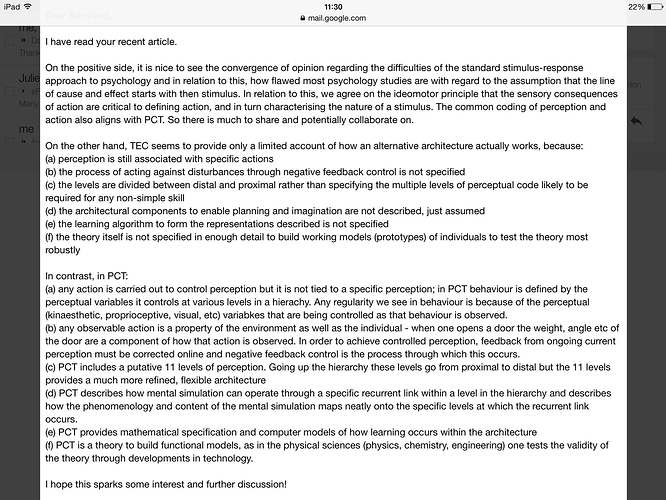Text version…
I have read your recent article.
On the positive side, it is nice to see the convergence of opinion regarding the difficulties of the standard stimulus-response approach to psychology and in relation to this, how flawed most psychology studies are with regard to the assumption that the line of cause and effect starts with then stimulus. In relation to this, we agree on the ideomotor principle that the sensory consequences of action are critical to defining action, and in turn characterising the nature of a stimulus. The common coding of perception and action also aligns with PCT. So there is much to share and potentially collaborate on.
On the other hand, TEC seems to provide only a limited account of how an alternative architecture actually works, because:
(a) perception is still associated with specific actions
(b) the process of acting against disturbances through negative feedback control is not specified
(c) the levels are divided between distal and proximal rather than specifying the multiple levels of perceptual code likely to be required for any non-simple skill
(d) the architectural components to enable planning and imagination are not described, just assumed
(e) the learning algorithm to form the representations described is not specified
(f) the theory itself is not specified in enough detail to build working models (prototypes) of individuals to test the theory most robustly
In contrast, in PCT:
(a) any action is carried out to control perception but it is not tied to a specific perception; in PCT behaviour is defined by the perceptual variables it controls at various levels in a hierachy. Any regularity we see in behaviour is because of the perceptual (kinaesthetic, proprioceptive, visual, etc) variabkes that are being controlled as that behaviour is observed.
(b) any observable action is a property of the environment as well as the individual - when one opens a door the weight, angle etc of the door are a component of how that action is observed. In order to achieve controlled perception, feedback from ongoing current perception must be corrected online and negative feedback control is the process through which this occurs.
(c) PCT includes a putative 11 levels of perception. Going up the hierarchy these levels go from proximal to distal but the 11 levels provides a much more refined, flexible architecture
(d) PCT describes how mental simulation can operate through a specific recurrent link within a level in the hierarchy and describes how the phenomenology and content of the mental simulation maps neatly onto the specific levels at which the recurrent link occurs.
(e) PCT provides mathematical specification and computer models of how learning occurs within the architecture
(f) PCT is a theory to build functional models, as in the physical sciences (physics, chemistry, engineering) one tests the validity of the theory through developments in technology.
I hope this sparks some interest and further discussion!
All the best,
Warren
···
On Thu, Dec 3, 2015 at 11:33 AM, Warren Mansell wmansell@gmail.com wrote:
For your interest CSGers!
http://bernhard-hommel.eu/Action%20control%20according%20to%20the%20theory%20of%20event%20coding.pdf
–
Dr Warren Mansell
Reader in Clinical Psychology
School of Psychological Sciences
2nd Floor Zochonis Building
University of Manchester
Oxford Road
Manchester M13 9PL
Email: warren.mansell@manchester.ac.uk
Tel: +44 (0) 161 275 8589
Website: http://www.psych-sci.manchester.ac.uk/staff/131406
Advanced notice of a new transdiagnostic therapy manual, authored by Carey, Mansell & Tai - Principles-Based Counselling and Psychotherapy: A Method of Levels Approach
Available Now
Check www.pctweb.org for further information on Perceptual Control Theory


